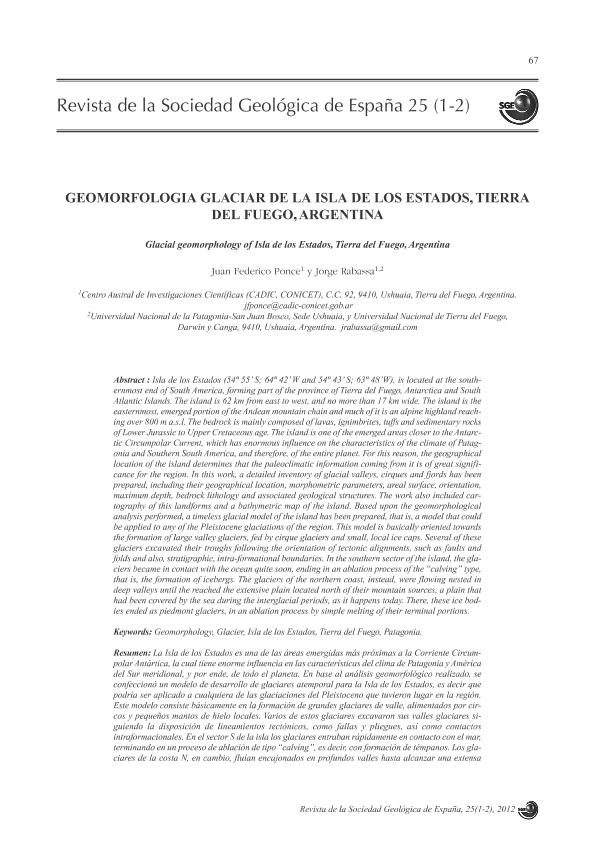Artículo
Geomorfologia glaciar de la isla de los estados, Tierra del Fuego, Argentina
Fecha de publicación:
03/2012
Editorial:
Sociedad Geológica de España
Revista:
Revista de la Sociedad Geológica de España
ISSN:
0214-2708
Idioma:
Español
Tipo de recurso:
Artículo publicado
Clasificación temática:
Resumen
Abstract : Isla de los Estados (54º 55? S; 64º 42? W and 54º 43? S; 63º 48?W), is located at the southernmost end of South America, forming part of the province of Tierra del Fuego, Antarctica and South Atlantic Islands. The island is 62 km from east to west, and no more than 17 km wide. The island is the easternmost, emerged portion of the Andean mountain chain and much of it is an alpine highland reaching over 800 m a.s.l. The bedrock is mainly composed of lavas, ignimbrites, tuffs and sedimentary rocks of Lower Jurassic to Upper Cretaceous age. The island is one of the emerged areas closer to the Antarctic Circumpolar Current, which has enormous influence on the characteristics of the climate of Patagonia and Southern South America, and therefore, of the entire planet. For this reason, the geographical location of the island determines that the paleoclimatic information coming from it is of great significance for the region. In this work, a detailed inventory of glacial valleys, cirques and fjords has been prepared, including their geographical location, morphometric parameters, areal surface, orientation, maximum depth, bedrock lithology and associated geological structures. The work also included cartography of this landforms and a bathymetric map of the island. Based upon the geomorphological analysis performed, a timeless glacial model of the island has been prepared, that is, a model that could be applied to any of the Pleistocene glaciations of the region. This model is basically oriented towards the formation of large valley glaciers, fed by cirque glaciers and small, local ice caps. Several of these glaciers excavated their troughs following the orientation of tectonic alignments, such as faults and folds and also, stratigraphic, intra-formational boundaries. In the southern sector of the island, the glaciers became in contact with the ocean quite soon, ending in an ablation process of the calving type, that is, the formation of icebergs. The glaciers of the northern coast, instead, were flowing nested in deep valleys until the reached the extensive plain located north of their mountain sources, a plain that had been covered by the sea during the interglacial periods, as it happens today. There, these ice bodies ended as piedmont glaciers, in an ablation process by simple melting of their terminal portions.
Palabras clave:
Geomorfología
,
Glaciaciones
,
Isla de los Estados
,
Tierra del Fuego
Archivos asociados
Licencia
Identificadores
Colecciones
Articulos(CADIC)
Articulos de CENTRO AUSTRAL DE INVESTIGACIONES CIENTIFICAS
Articulos de CENTRO AUSTRAL DE INVESTIGACIONES CIENTIFICAS
Citación
Ponce, Juan Federico; Rabassa, Jorge Oscar; Geomorfologia glaciar de la isla de los estados, Tierra del Fuego, Argentina; Sociedad Geológica de España; Revista de la Sociedad Geológica de España; 25; 1-2; 3-2012; 67-84
Compartir




